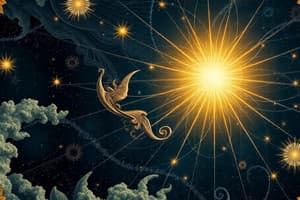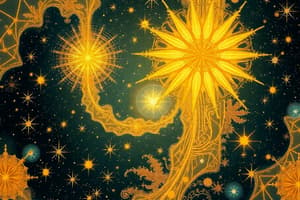Podcast
Questions and Answers
What is a dwarf star?
What is a dwarf star?
- A large star with high luminosity
- A star that is the same size as the sun
- A small star up to 20 times larger than our sun (correct)
- A star that has no nuclear fusion
What type of star is the Sun?
What type of star is the Sun?
- Blue giant
- Red giant
- Yellow dwarf (correct)
- Neutron star
What temperature characterizes a red dwarf?
What temperature characterizes a red dwarf?
Under about 4,000 K
What is a red giant?
What is a red giant?
What characterizes a blue giant?
What characterizes a blue giant?
What happens when supergiants die?
What happens when supergiants die?
What is a white dwarf?
What is a white dwarf?
What is a brown dwarf?
What is a brown dwarf?
A pulsar is a rapidly spinning ______ star that emits energy in pulses.
A pulsar is a rapidly spinning ______ star that emits energy in pulses.
What is a binary star?
What is a binary star?
What is an eclipsing binary?
What is an eclipsing binary?
What characterizes X-ray binary stars?
What characterizes X-ray binary stars?
What are Cepheid variable stars known for?
What are Cepheid variable stars known for?
What is a Mira variable star?
What is a Mira variable star?
Flashcards are hidden until you start studying
Study Notes
Dwarf Stars
- Dwarf stars are small stars, ranging up to 20 times the size of the Sun and up to 20,000 times its brightness.
- The Sun qualifies as a dwarf star.
Yellow Dwarf
- Yellow dwarfs are small, main sequence stars.
- The Sun is categorized as a yellow dwarf.
Red Dwarf
- Red dwarfs are small, cool stars with surface temperatures under 4,000 K.
- These stars are the most common type in the universe; an example is Proxima Centauri.
Giant and Supergiant Stars
- Giant and supergiant stars are characterized as large, older stars.
Red Giant
- A red giant is significantly larger in diameter, around 100 times its original size, and cooler (surface temperature under 6,500 K).
- Betelgeuse is a notable red giant, about 20 times more massive than the Sun and roughly 14,000 times brighter.
Blue Giant
- Blue giants are massive, hot stars that burn helium and are post-main sequence.
Supergiant
- Supergiants are the largest known stars, some nearly as expansive as the solar system.
- Betelgeuse and Rigel are examples; they are rare and may end their life cycle as black holes after a supernova.
White Dwarf
- White dwarfs are small, dense stars primarily composed of carbon, remnants of red giants after they shed outer layers.
- They are around the size of Earth but significantly heavier and will eventually cool into black dwarfs. The Sun will evolve into a white dwarf.
Brown Dwarf
- Brown dwarfs have insufficient mass for nuclear fusion; they are dim and have a mass range of 10^28 kg to 8.4 x 10^28 kg.
Neutron Star
- Neutron stars are incredibly dense, composed mainly of neutrons, with diameters of 5-10 miles (5-16 km) and extreme densities of approximately 10^15 gm/cm³.
Pulsar
- Pulsars are rapidly spinning neutron stars emitting radiation in pulses.
Double Star
- A double star system consists of two stars appearing close to each other; some are true binaries while others are optical doubles.
Binary Star
- A binary star system involves two stars orbiting their common center of mass (barycenter); about half of all stars pair with at least one other star.
Eclipsing Binary
- Eclipsing binaries are two stars that periodically obscure or enhance each other's brightness, viewed edge-on from Earth.
X-ray Binary Star
- X-ray binaries contain a collapsed star (like a white dwarf or neutron star) paired with a normal star; X-rays are produced as matter is drawn from the latter towards the collapsed object.
Cepheid Variable Stars
- Cepheid variables regularly change in size and brightness; as they expand, brightness decreases, and vice versa.
- Examples include Polaris and Delta Cephei.
Mira Variable Star
- Mira variables undergo prominent changes in brightness and size over long periods, sometimes varying by as much as 6 to 8 magnitudes.
- Named after the star Mira, which had its fluctuations discovered in 1596.
Studying That Suits You
Use AI to generate personalized quizzes and flashcards to suit your learning preferences.






